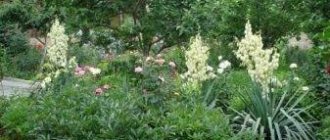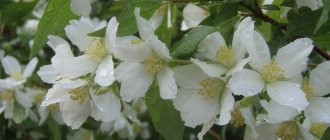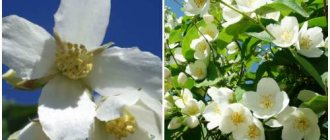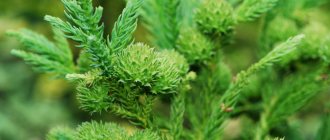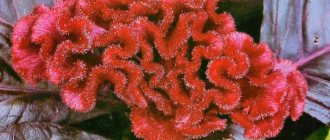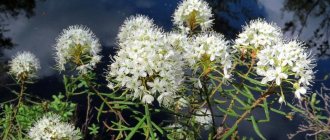Mock orange is an amazing flowering shrub that can become a real decoration for any garden. At the peak of its flowering, it turns into a snow-white cloud. There are varieties with different flowering times, which allows you to enjoy the beauty and aroma from May to August. They also distinguish: low, medium and tall varieties, which allows you to create a unique composition on the site.
The plant is often called jasmine due to its visual similarity and the pleasant subtle aroma of the flowers. Still, jasmine and mock orange are different plants that belong to different botanical families and require different care.
The bush got its name due to the soft core and hard wood from which mouthpieces and pipes for smoking pipes were made. The Latin name of the plant is philadelphus in honor of the Egyptian king Ptolemy Philadelphus.
Features of growing mock orange
The growing process is not particularly difficult. It is important to pay special attention to the plant during the first three years of growth. The future fate of the plant and its appearance depend on the correct planting, care and care.
How and when to plant mock orange
This is a light-loving plant that prefers to grow in open areas. The splendor of flowering depends on the degree of lighting. In the shade there will be few flowers, they will be small, and the shoots will be very long.
As for the soil, the ideal option would be to make your own substrate. To do this, you need to take leaf soil, sand and humus in a ratio of 3:2:1. During the first growing season, this mixture will provide the plants with the necessary nutrients. If the soil at the planting site has low water permeability, additional drainage will be required. Stagnant water can destroy the plant.
Recommendations for landing:
- For planting you will need to prepare a hole. Its size must correspond to the volume of the root system of the seedling that will be used. As a rule, it is enough to dig a hole 60 centimeters in diameter and the same depth.
- If you plant mock orange in groups, you need to take into account that the crowns of the bushes are quite voluminous. Because of this, the distance between seedlings should be about 1.5 meters. When creating a hedge, it is recommended to reduce the distance to 70 centimeters.
- It is advisable to lay a drainage layer at the bottom of the hole to prevent water stagnation.
- After this, the seedling is placed in the hole and covered with a previously prepared substrate of sand, humus and leaf soil.
When planting, special attention should be paid to the root collar. It is important that it is immersed in the ground no more than 2 centimeters. Otherwise, rotting and, as a result, death of the bush is possible.
Planting mock orange can be done in early spring, before the first buds appear, or in the first half of autumn. In any of the options, the chance of seedling survival is quite high, since the plant is not whimsical and has excellent frost resistance.
Chubushnik magical aroma: domestic varieties for Central Russia
Mock orange (Philadelphus) is one of the most popular ornamental shrubs, blooming spectacularly in early and mid-summer. The genus was named by Charles Lineus in honor of the Egyptian king Ptolemy Philadelphus (285-247 BC), who was extensively involved in the natural sciences. And the Russian name is due to the fact that parts of smoking pipes - chibuki - were made from the stems of the bush, which have a loose, easily removed core. It is sometimes called garden jasmine or simply jasmine for its white flowers, similar in aroma to the flowers of representatives of the genus Jasminum - tropical evergreen shrubs from the Olive family, native to India and Southeast Asia.
Mock oranges were introduced into garden culture in Central America, Asia Minor and East Asia already in the 12th-13th centuries. In Russia in the 16th-17th centuries, these plants, along with lilacs and roses, were widespread in royal and boyar gardens. The beginning of the cultivation of species of American and Asian origin in Europe dates back to the first half of the 19th century, when the bulk of species of the genus Chubushnik were introduced into European botanical gardens.
In nature, according to various sources, there are from 60 to 70 species that live in the temperate latitudes of the Northern Hemisphere on the Eurasian and American continents. On the territory of Russia in the Far East, thin-leaved mock orange (Philadelphus tenuifolius) and Shrenka (Ph. schrenkii) grow, and in the undergrowth of mountain forests of the Caucasus - Caucasian mock orange (Ph. caucasicus).
Depending on the species and variety, mock orange blooms on last year's shoots from late May to late July. The time frame is two to three weeks. In hot weather, mock oranges bloom earlier and for less time. If the shrub is planted in partial shade, then flowering occurs later, and it blooms longer.
Mock orange Lemoine
Different types and varieties of mock orange have the smell of real jasmine, honey, acacia and even fresh herbs. Some varieties are known for their fruity scents. As a rule, species-specific mock oranges have a stronger aroma compared to varietal ones. Flowers smell thanks to the content of essential oils. Evaporating, essential oils surround the plant with an invisible cloud and protect it from overheating during the day and hypothermia at night.
Many famous breeders worked with mock oranges, but the famous French one made the greatest contribution.
The family history began with Victor Lemoine (1823-1911), a famous breeder who produced numerous varieties of lilacs, deutsii, weigels, clematis and mock oranges. In 1850 he founded his own nursery in Nancy. The breeding work of Victor Lemoine was continued by his son Emile Lemoine (1862-1942) and grandson Henri Lemoine (1897-1982).
Since the mid-30s of the 20th century, work on the hybridization of mock oranges was continued by the American breeder Guy George Bush (Guy. D. Bush, 1898-1974), who created the variety 'Miniesota Snowflake', famous in Russia.
Of the Canadian breeders, it should be noted Frank Skinner (Skinner FL, 1882-1967), author of the varieties 'Patricia', 'Purity', 'Thelma', and George Sampson (DR Sampson). He is the author of the varieties 'Snowbelle' (1979) and 'Snowgoose' (1986).
A great contribution to the selection of mock oranges in Russia was made by Professor Nikolai Kuzmich Vekhov (1887-1956), who carried out his work at the Lipetsk Forest Research Station (LOSS) in the 30-40s of the last century. Vekhov and the staff of LOSS created 28 hybrid forms, many of which received copyright certificates and were recognized as varieties.
In the Botanical Garden of Moscow State University in 2014, a collection of Vehova varieties was created, which currently includes 19 varieties. They are all quite winter-hardy, unpretentious and most suitable for the Russian climate. And the entire collection of mock oranges of the Botanical Garden includes seventeen species, 37 domestic and foreign varieties.
Schrenk's mock orange
In Moscow conditions, Schrenk's mock orange (Philadelphus schrenkii) is the first to bloom in early June. The flowers are white, up to four centimeters in diameter, with a strong aroma. Blooms from late May to the third decade of June. The height of the bush can reach three meters. It came into culture from China, Korea, and the Far East. It is winter-hardy, tolerates frosts down to −25 º C. Even when frozen to the level of snow cover, it quickly grows back after spring pruning.
At approximately the same early date, sometimes several days later, small-leaved mock orange (Ph. microphyllos) blooms. Its homeland is North America. It forms a multi-tiered low-growing bush up to 1.6 meters high, with a crown diameter of up to 1.4 meters. The crown is openwork, see-through, formed by thin brownish-red shiny shoots. The leaves are lanceolate, pointed, medium-sized, up to one and a half centimeters long, dark green above, bluish below. The flowers are white, 2.5 centimeters in diameter, often solitary. Strawberry-scented flowers completely cover the bush during flowering. Blooms from June 7 to June 24. Looks impressive in groups and single plantings.
Mock orange crown
The most common in ornamental gardening is the crown or common mock orange (Philadelphus coronarius). Cultivated in gardens and parks all over the globe. Despite the fact that the mock orange is native to the south of Western Europe, it can withstand frosts down to −25º C. The shrub reaches three meters in height and has large, jagged leaves along the edges. The cream flowers are simple, very fragrant, up to 3.5 centimeters in diameter, collected in clusters of five to seven pieces. It blooms for quite a long time, up to 18 days from June 10-15 to June 28-30.
One of the latest species of mock orange is the Lemoine mock orange - Philadelphus x lemoinei (Ph. coronarius Ph. x microphyllus). The hybrid was obtained in 1892. This is a shrub one and a half to two meters high with a spreading crown of beautifully curved shoots. The flowers are large, up to four centimeters in diameter, goblet-shaped, cream-colored, the edges of the petals are wavy, with a strong scent, collected in brushes of three to seven pieces. The stamens of the flower are yellow. Blooms from June 25 to July 12. The shrub is unpretentious and winter-hardy. Best suited for free-growing hedges.
Let us dwell on some domestic varieties that have proven themselves well in the conditions of Central Russia.
'Pearl'
Variety 'Pearl' (Vekhov N.K., LOSS, 1961) . The bush is spreading, up to 1.8 meters high, crown diameter is 2.5 meters. The leaves are large, bright green with a shine. The inflorescence is up to seven to eight centimeters long, with four to five flowers. The variety is extremely impressive thanks to its large, double, goblet-shaped flowers. The outer petals are wide, white, with a pearlescent tint; internal ones are numerous, narrower, slightly curved. Blooms early - June 14-16. The aroma is pleasant, but not strong. Flowering continues until July 2-4. Looks good when planted alone.
Variety 'Academician Komarov' (Vekhov N.K., 1951) . The bush is 1.7 meters high, crown diameter is 1.4 meters. The shoots are directed vertically. The variety has very large (up to 6.5 centimeters in diameter) snow-white, non-double flowers of five in small inflorescences with a faint odor. The corolla of the flower is wide open and consists of five wide petals. It blooms on average from June 18-20 to July 8-10. Suitable for free-growing hedges.
'Zoya Kosmodemyanskaya'
'Zoya Kosmodemyanskaya' (Vekhov N.K., 1951) is unsurpassed in beauty . A distinctive feature of this variety is its very long (up to 25 centimeters) densely spaced flowering shoots. Inflorescences of seven to nine flowers. The flowers are semi-double, large, with wide-oval outer and narrow-oval inner petals, cream-colored, with a not very strong pleasant smell. Shrub with a medium flowering period (from June 20 to July 10). In garden design, the shrub is suitable for single plantings, groups and hedges.
'Zoya Kosmodemyanskaya'
At first glance, we recognize the variety 'Airborne' (Vekhov N.K., 1951) . The height of the bush is 1.7 meters, the crown diameter is one and a half meters. The shoots are vertical. The flowers are simple, small, cup-shaped, with four creamy oval petals and yellow stamens, collected in long racemes of seven to nine flowers. In shape they resemble lily of the valley flowers. Particularly interesting is the drooping shape of the flowers at the beginning of the buds. The flowers do not open completely. They have a strong, fruity smell. The variety is distinguished by early flowering, from June 16 to July 2. Good for hedges.
'Airborne'
'Memory of Vekhov' (LOSS, 1980) . The variety was obtained from the hybrid fund of N.K. Vekhov. The bush grows to a height of two meters, the diameter of the crown is 1.6 meters. The leaves are large, shiny dark green, finely serrated. Double flowers with bright yellow stamens are collected in an inflorescence in the form of a bunch. The inflorescences are dense, consisting of three to five flowers with a diameter of four centimeters. The outer petals are oval and do not overlap. The inner petals are wide and narrow, shorter than the outer ones. The flowers have an unusual yellow-green color. It is especially noticeable in contrast with mock orange varieties with snow-white flowers. The aroma is strong, flowering is abundant. The variety blooms for a long time from June 18-21 to July 15-20.
'Memory of Vekhov'
The rare variety 'Arctic' (Vehov N.K., 1951) has characteristic pure white star-shaped flowers, almost odorless. The outer petals are oval, pointed, the inner ones are numerous, narrow, fringed, curved. The inflorescence itself is short, but there are up to nine flowers on it. The bush is 1.7 meters tall and has a crown diameter of 2.5 meters. Flowering is long-lasting, from June 20 to July 10. Thanks to its spreading, weeping crown, formed by arched, cascading shoots, the shrub looks impressive when planted alone.
'Arctic'
The latest flowering variety is 'Moonlight' (Vekhov N.K., 1941) . The height of the bush is up to 1.7 meters, the diameter is one and a half meters. The buds are round and cream-colored. The flowers are in bunches, often of three, double, greenish-cream, medium-sized, 3.5 centimeters in diameter. The lower petals are oval, overlapping, beautifully curved, the inner ones are wide and narrow fringed. The stamens are yellow. The aroma of flowers is subtle, strawberry. It is a long-flowering variety. The shrub blooms on June 20-24 and fades on July 12-15. Looks great when planted alone.
'Moonlight'
Next time we will tell you about varieties of foreign selection suitable for cultivation in central Russia, as well as about the agricultural technology of mock orange.
BOTSADY.ru
The BOTSADY.ru portal operates with the support of the PR agency “Gurov and Partners”
How to care for mock orange
This is not a whimsical plant that can grow in natural conditions without human intervention. Still, to get a truly beautiful and lushly flowering bush on your site, you need to put in a little effort.
Watering
The shrub does not have high drought resistance; therefore, it requires timely watering. In hot summers it is necessary to water at least once every two days. In the absence of sufficient moisture, the leaves quickly droop. Under normal conditions, watering is necessary 1-2 times a week. In this case, you need to pour 2-3 winds of water under the tree trunk.
After each watering, it is recommended to loosen the soil near the mock orange and remove weeds. To save time, you can mulch the soil near the trunk with shavings or straw. This technique will also reduce the frequency of watering, since the moisture will not evaporate so quickly.
Top dressing
For normal growing season and abundant flowering, it is necessary to add nutrients in a timely manner. It is important to feed the plant in early spring using purchased nitrogen-based complex fertilizers or make a solution of mullein (1:10) and pour it under the bush.
The second time you need to fertilize at the end of the flowering period. To do this, potash (1 tablespoon) and phosphate (2 tablespoons) fertilizers are diluted in a bucket of water and poured under the bush. Instead of mineral fertilizers, you can use ash. It is enough to distribute 2 cups of ash evenly under the bush and cover it a little with earth. Before wintering, it is advisable to spread compost or humus in a 5-centimeter layer around the tree trunk.
Trimming
Pruning is an important stage of care, since in mock orange flower buds are laid on annual shoots. To do this, after the flowering stage, you need to cut off all the branches with dried inflorescences. This will allow nutrients to be sent to strengthen the shoots. In addition, pruning will create a beautiful shape for the crown of the bush. In this case, it is necessary to cut off weak or damaged branches.
Even neglected and unkempt bushes can be restored with spring pruning. Before sap begins to flow, cut off all branches at the root. You only need to leave a few of the strongest shoots up to 30 centimeters long. It is from these stumps that the mock orange will be reborn. New young shoots will allow you to form a beautiful decorative crown.
Wintering
Preparing for winter does not require much effort, since most species are winter-hardy. But when purchasing a young seedling, it is worth clarifying the degree of frost resistance of this variety.
In very severe frosts, the above-ground part of the mock orange can freeze completely. But with the onset of spring, the root system quickly restores the bush and produces new young shoots. Because of this, before the onset of cold weather, it is recommended to carry out a little insulation of the roots. To do this, it is enough to mulch the area near the trunk with a layer of peat, straw or dry grass. With the arrival of spring, the mulch needs to be removed.



